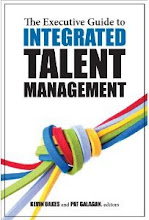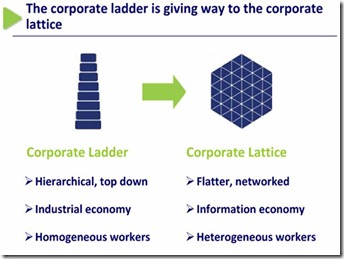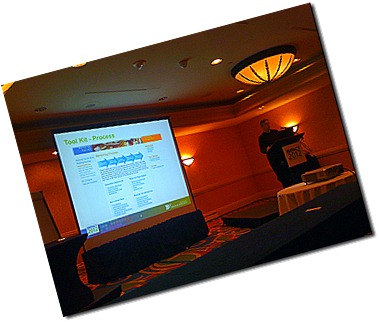 Of course in most of the reports I’ve been reviewing, there are also the requisite comments on needing to measure talent better. Eg the PwC report:
Of course in most of the reports I’ve been reviewing, there are also the requisite comments on needing to measure talent better. Eg the PwC report:
“CEOs are also seeking a better understanding of the scale and
effectiveness of their investments in talent. Productivity and labour cost remain important measurements; these are the tools investors, lenders and businesses use to benchmark progress (or lack of it). They are largely standardised in many industries, and thus easy to implement. Yet for many CEOs, those tools aren’t enough. They are very good at telling a CEO how the business is performing today relative to its peers, but not at indicating whether the organisation is investing enough in employees to generate future growth.
Such measurements cannot isolate skills gaps and struggle to identify the pivotal jobs that drive exponential value; they do not measure employee engagement or team performance, both of which are so critical for investments to foster innovation to bear fruit. These measurements are much harder to make, which is one reason why they’ve been neglected and why today, so many CEOs are frustrated with the issue of talent.”
The argument is made clearer in Workday’s recent report, Taking Measure of Talent, published by Harvard Business Review:
“Yet in many companies there has been a lack of understanding and visibility into how human capital is managed — a shortage of analytical insights about where investments are made, what form the investments take, their impact, and how best to shift resources and practices. In a survey by Mercer, for example, CFOs reported that their organizations spent 36 percent of revenue on human expenses, but only 16 percent said they had anything more than a moderate understanding of the return on human capital investment. In a similar study of 3,000 senior managers, executives gave their firms low marks when describing the employee-related data they need for decisions. The gap between the data they needed and actual quality of the data they received, leaders said, was more than 50 percentage points.
Clearly, these business leaders, including HR executives, are concerned that they are not making decisions with the same rigor with which they make decisions about marketing, supply chains or product strategies. And without clear metrics and a deep view into data on the workforce, the organizations have not had business intelligence reporting on their key assets — and have not had access to insights to create strategies to drive better business performance.
There are clear associations between a company’s financial performance and strong talent management practices when they are targeted to real business needs. A global study by McKinsey & Company found that companies that scored highest in global talent management practices earned significantly higher profit per employee — almost 30 percent — than those companies that scored lowest on the human capital measures.”
This reads like a problem but the real issue here is simply that CEOs and their Heads of Talent haven’t figured out that it’s not just that these measures are hard to make, it’s that a lot of the more value adding and creating attributes a CEO would like to know, eg on skill gaps and pivotal jobs, simply can’t be measured in ways that would be ‘adequate’ in other business functions, that understanding is never going to be more than ‘moderate’ and that they’re just not going to be able to make decisions with the ‘same rigour’ as for marketing, supply chains and product strategies.
However, the issue about all of this isn’t only that CEOs are going to be disappointed, it’s that the attempt to add rigour is likely to drive businesses towards lower value approaches to talent management – exactly what heads of talent shouldn’t want to do.
How’s that? Well, in general terms, the easier something in HR is to measure, the more likely it is to be pretty low value. And the reverse it true as well – the higher the value, the more difficult to measure it’s likely to be. So the more we focus on measures, the more likely it is that we’ll be drawn to low value approaches because these are the things we can measure…
Take the case of an organisation with a data warehouse. There are two main challenges here. The first is in ensuring that all relevant data elements (higher and lower value) are captured in the warehouse. Otherwise and correlations which are found may just be predictive, not truly causal, with the real cause existing outside of the warehouse system. But more importantly, as most of the data elements are likely to be lower value, any strategies that emerge from the analysis are likely to be lower value too. So it is important that these lower value strategies are supplemented with higher value ones.
But these higher value strategies are going to require Heads of Talent to look at areas where data may be less adequate and decision making less rigorous. Take for example, this quote from the Heidrick & Struggles report:
“We’re a very lean organisation so it’s easy to follow the people in my pool and get a good sense of whether they are happy or not.”
And that requires more comfort with this different type of data and analysis – another significant challenge for heads of talent!
- Consulting - Research - Speaking - Training - Writing
- Strategy - Talent - Engagement - Change and OD
- Contact me to create more value for your business
- jon [dot] ingham [at] strategic [dash] hcm [dot] com
.


























 I only managed to catch the final session yesterday but it was a good one.
I only managed to catch the final session yesterday but it was a good one. Welcome to the new HR carnival,
Welcome to the new HR carnival, 










